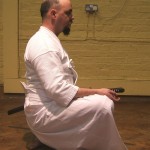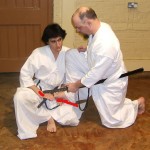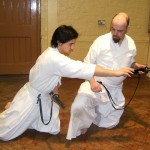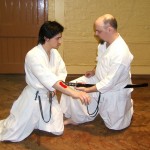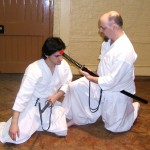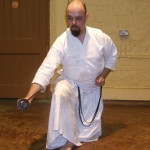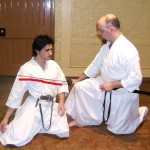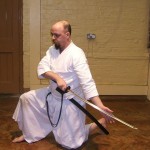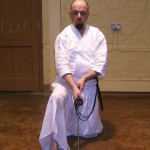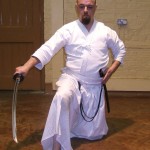Yamaoroshi
Yamaoroshi-Mountain Storm/Wind.
Yamaoroshi is the 5th Hasagawa Eishin ryu kata from Musoshindenryu’s Chuden or tatehiza-no-bu. The usual interpretation of this kata is that one forestalls an enemies attempt to draw his sword by striking his sword hand with the handle of your sword whilst suppressing his left hand with your right foot and body. This is followed up by three cuts to the enemies body. I have also been taught that your initial response is against an attempt to seize your sword, that the tsuka is used to strike the head after the hand, and that there is no controlling stamp early in the kata. If you follow MusoJikidenEishinryu your interpretation will differ again.
Begin standing, facing the front, with your left thumb covering the tsuba.(pic 1) Turn to your left and assume tatehiza.(pic 2&3) It is normal, but not universal, for your hands to be partially open-palms uppermost, and your sageo(if used) to be left hanging down the middle. It is interesting to note that this position differs from the tate-hiza in Seitei Iaido. In Seitei the hands are bunched up with the palms down, the sageo is placed to the left, and the left leg is almost straight below the body. In koryu it is important to push out the knees creating a stable base. Beginners find this hard and often ‘topple over’!
Your opponent is sitting to your right, also in tatehiza. He begins to go for his sword.(pic 4) You notice this and respond by bringing your tsuka(handle) round in an anti-clockwise direction, pivoting on your left knee, and then down onto his right hand. This motion is completed with your left hand. You simultaneously stamp down with your right foot onto his left wrist.(pic 5) Note that in effect you are pinning his left leg to the ground and stopping him from rising. I have also been taught these movements with some variations. Sometimes the opponent is thought to grab for your sword and you counter his right wrist. Sometimes the controlling stamp is not shown. In some schools when the tsuka is brought back round it is used to strike the opponents head on the way down. I have illustrated some of these other interpretations in the photos.(pics 6, 7, & 8)
Next slide your body towards your opponent moving on your left knee and bring the tsuka round in a clockwise fashion. This is a smothering, controlling movement which stops the opponent from countering. As you slide forwards bring your right hand to the tsuka, and push the tsuba forwards with your left thumb-koiguchi-wo-kiru, and draw the sword(pic 9)-cutting the enemy across the lower chest area. This cut should be diagonal, to the side and with a lot of sayabiki.(pics 10 & 11))
Immediately following this cut, the katana is pushed through the opponent in a diagonal fashion, and to the right. During this action you move your right leg round and your left hand pushes the blade through your enemy. At the end of this action the blade is held high and the left hand has moved towards the tsuba.(pics 12, 13, &14)
Following this action bring the sword round in a circular action into a high jodan position as you reposition your body to face forwards again.(pics 15 & 16) Stamp down firmly on your opponents arm with your right foot, and then execute kirioroshi-a decisive vertical cut to his abdomen.(pic 17)
Complete yoko-chiburi, shaking the blood off to the right.(pic 18) This action, although largely symbolic, should be done with the intent of shaking the blood and bits off your sword. The idea of this action is to make sure that your katana does not become stuck in the scabbard, leaving you vulnerable to an attack. In reality the sword would be wiped clean-probably on the enemies clothes, or with a piece of cloth-prior to resheathing.
Next complete noto by bringing the sword back and the saya forwards, followed by bringing the sword forwards and the saya back. In Musoshinden ryu the blade remains horizontal during the first stage, turning a third of the way through the second stage. In Chuden the koiguchi meets the mune further down the sword than in Omori ryu in most dojo. In the final stage of noto you resheathe the blade as you kneel down slowly resheathing the blade whilst turning the saya clockwise back to the vertical(pic 19). Stand up by moving your right foot forwards and your left leg up. You should still exhibit zanshin. Pause and relax your right hand and move back to your starting position. Pic 20 shows Chris in a beautiful Japanese garden- I had just been training in the preserved ‘Daimyos ryokan’ inside.

